Accessible Boating Facilities - A Summary of Accessibility Guidelines for Recreation Facilities
Boat Slips
A boat slip is the portion of a pier, main pier, finger pier, or float where a boat is berthed or moored, or used for embarking or disembarking. Where boat slips are provided, the number of boat slips required to be accessible must comply with the table shown to the right. In these guidelines, boarding piers that are not part of boat launch ramps are also classified as boat slips. For purposes of these guidelines, piers not typically thought of as providing boat slips where boats can be moored, such as a fuel pier, are also included in determining the total number of slips at the facility.
| Total Boat Slips in Facility | Minimum Accessible Slips |
|---|---|
| 1 to 25 | 1 |
| 26 to 50 | 2 |
| 51 to 100 | 3 |
| 101 to 150 | 4 |
| 151 to 300 | 5 |
| 301 to 400 | 6 |
| 401 to 500 | 7 |
| 501 to 600 | 8 |
| 601 to 700 | 9 |
| 701 to 800 | 10 |
| 801 to 900 | 11 |
| 901 to 1000 | 12 |
| 1001 and over | 12, plus 1 for each 100 or fraction thereof |
If boat slips at a facility are not identified or demarcated by length, each 40 feet of boat slip edge along the perimeter of a pier will be counted as one boat slip. For example, a new boating facility will provide a single 60-foot pier with boats moored parallel to the pier on both sides. The pier has 120 feet of boat slip edge, which equates to three boat slips. According to the table, one slip must be accessible, with clear pier space at least 40 feet long and a minimum width of 60 inches. In this case, the width of the pier is not considered when totaling the amount of boat slip edge, since it is not designed for mooring. Another new boating facility plans to provide a single pier that is 25 feet long and 3 feet wide and will allow boats to moor on both sides and on one end. The pier has 53 feet of boat slip edge, which equates to two boat slips. According to the table, one slip must be accessible, and the width of the pier must be increased to a minimum of 60 inches.
Dispersion
Accessible boat slips must be dispersed throughout the various types of slips a facility provides, but a facility does not have to provide more accessible boat slips than required in the table. Accessible slips may be grouped on one pier if the requirement for different types of slips is met. Types could include shallow-water or deep water; transient or longer-term lease; covered or uncovered; and whether slips are equipped with features such as telephone, water, electricity, or cable connections.
Accessible boat slips do not need to be marked and are not reserved in the same way as accessible vehicle parking spaces. For example, facilities should hold the accessible slips open for persons with disabilities until all other slips are filled. At that point, the slip may be made available for general use. For seasonal slip holders, accessible slips should be held until the expiration period for slip contracts has expired. Marina operators may choose to make information regarding accessible boat slips available in promotional material or a facility guide. Ensuring that accessible slips are available to persons with disabilities is an operational issue and operators should contact the Department of Justice for further information.
Accessible Boat Slips
Accessible boat slips must have clear pier space at least 60 inches wide and as long as the slip. Providing more than 60 inches wide clear space will improve safety for people with disabilities, especially on floating piers. This space is the minimum necessary for individuals with disabilities to have sufficient space adjacent to their boat slip to use a chair lift or transfer device for getting on or off their vessel and provide a turning space for changing directions. Every 10 feet of linear pier edge serving the accessible slips must have at least one continuous clear opening that is at least 60 inches wide. There are three exceptions:
-
-
The width of the clear pier space may be 36 inches wide for a length of 24 inches, as long as multiple 36-inch segments are separated by segments that are 60 inches minimum clear in width and 60 inches minimum clear in length, and the clear openings are at least 60 inches deep.
-
Edge protection is not required, but if provided, it can be 4 inches high maximum and 2 inches deep maximum at the continuous clear openings.
-
- In alterations, facilities with finger piers must have at least one accessible finger pier, which is the length of the boat slip and a minimum of 60 inches wide. Other accessible slips can be located perpendicular to the end of the pier with clearance extending the width of the slip. In facilities without finger piers, at least one accessible slip must be parallel to the pier and be a minimum of 60 inches wide.
Cleats and other boat securement devices at accessible slips do not have to comply with ADAAG reach range requirements. However, clear space must be provided at each securement device and each device must be located on an accessible route. This reach range exception does not apply to other controls and operating mechanisms such as hose bibbs, water supply hoses, outlets for electrical power, telephones, or cable TV.

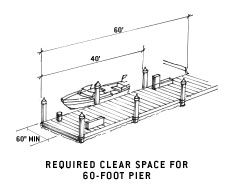
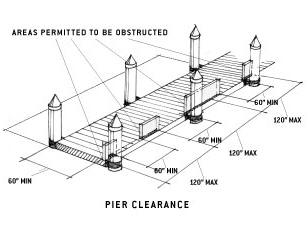
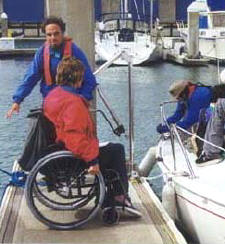
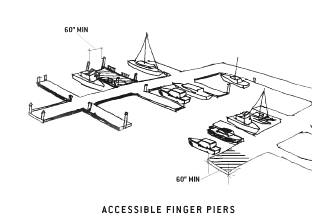
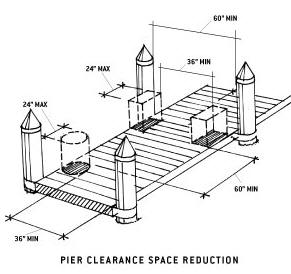
User Comments/Questions
Add Comment/Question